A Decade of Restoring Mangroves
at The Bonefish Pond National Park
Prior to its establishment as a national park in 2002, The Bonefish Pond National Park was used as an illegal dumping ground. Since 2008 a number of restoration projects have been undertaken with the aim of returning the park to its pristine condition.
By: Elijah Sands
Photos By: Elijah Sands, Zaria Dean, and Others Listed
August 15, 2022
Prior to its establishment as a national park in 2002, The Bonefish Pond National Park was used as an illegal dumping ground. Since 2008 a number of restoration projects have been undertaken with the aim of returning the park to its pristine condition.
The Bonefish Pond National Park (BPNP), located on the southern side of New Providence protects 1,235 acres of coastal habitat. Despite the ‘pond’ in its name, The Bonefish Pond National Park is directly connected to the ocean. Therefore, the mangrove ecosystem in this park serves as an important nursery habitat for the nearby offshore coral reefs by providing shelter for commercially important fish like snapper, grouper, grunts and crawfish during their most vulnerable stage of life – when they’re juveniles.
The park is bordered by the Cowpen, Millars Creek, Bacardi and Marshall Road communities. During inclement weather events, there’s no doubt this park helps to protect these surrounding communities from storm surges and flooding. The park is also a very popular place for recreational activities. Locals and visitors alike explore the beautiful mangrove ecosystem in this park by walking along the boardwalk or getting in the water for kayaking, snorkelling, or just to relax. The park is certainly a natural gem and should be treated as such. What you see today at The Bonefish Pond National Park is a far cry from what it used to be. Historically, in The Bahamas, the importance of mangroves wasn’t appreciated by the masses. This meant these wonderful wetlands were frequently treated as wastelands.
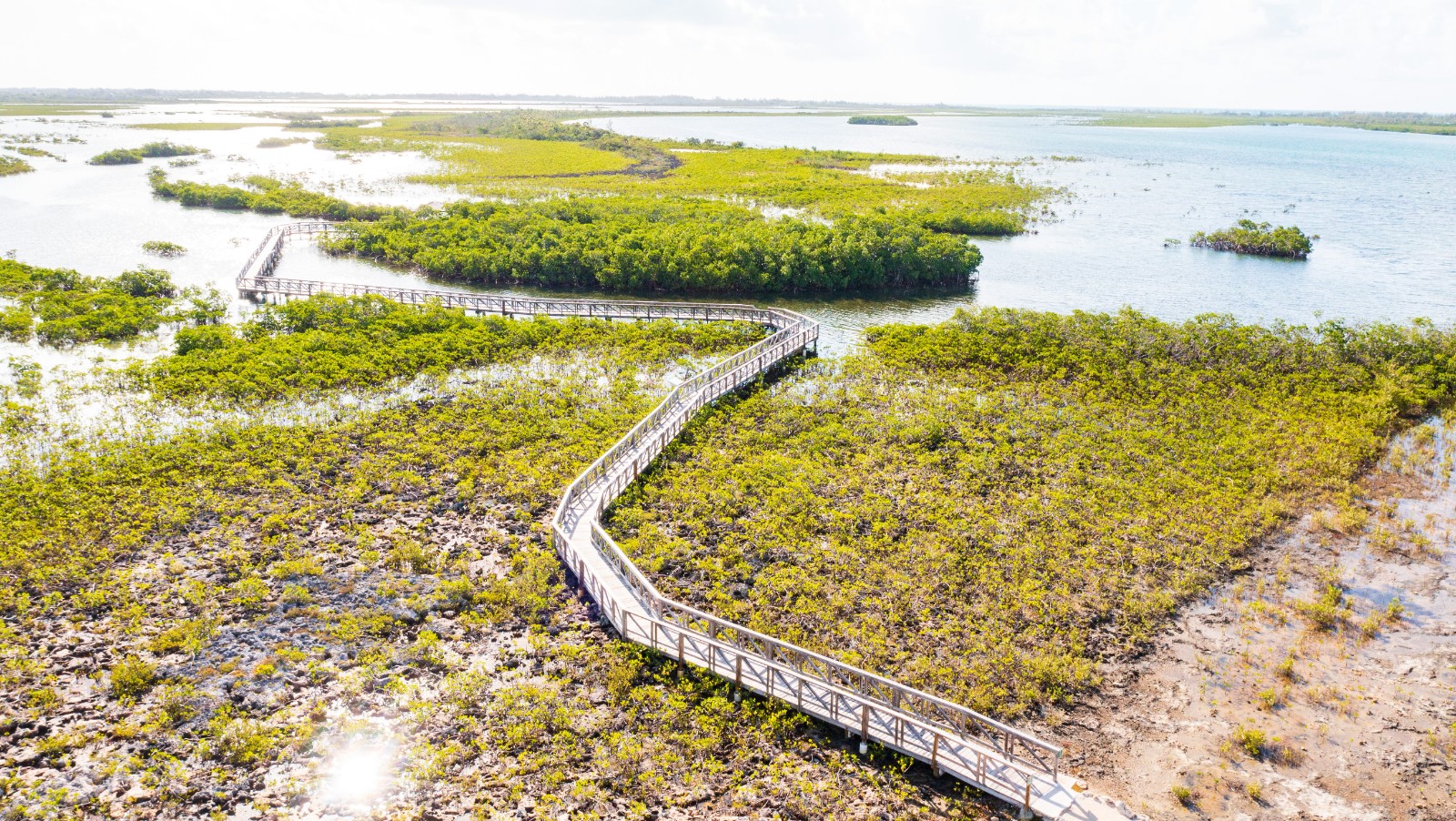
Today, The Bonefish Pond National Park is a place where Bahamians and visitors alike can explore the beauty of the mangrove ecosystem
Prior to its establishment as a national park in 2002, several areas in the park were used as illegal dumping grounds and copper burning sites. When the BNT acquired management of the area, there were huge mounds of trash (some nearly 10’ tall) that have been dumped in various places in the park. Any and everything was found amongst this debris; vehicles, furniture, septic tanks, tires, mounds of metal, plastic, and so much more. It was clear that if this area was ever to be returned to a more pristine condition, or be an area that people can enjoy, it would need a serious, long-term cleanup and restoration effort. Since 2008, a number of projects and initiatives have been led by The BNT with the aim of improving the health and productivity of this national park.
Early ecological assessments from a team comprised of staff from The Perry Institute for Marine Science and the BNT revealed that the park needed several interventions to help rejuvenate the park which included continuous cleanup efforts, tidal flow improvement, mangrove restoration in degraded areas, and community engagement to curb pollution.
One of my favourite journeys at the BNT so far has been documenting the incredible biodiversity found within this national park. From the birds that feed and nest in the mangroves, to the fish, crustaceans and other marine life that call these creeks and ponds home. Besides that, another really impactful journey has been documenting and also getting involved with many of the recent conservation efforts at this national park since I joined the BNT nearly 6 years ago.
“It was clear that if this area was ever to be returned to a more pristine condition, it would need a serious, long-term cleanup and restoration effort.”



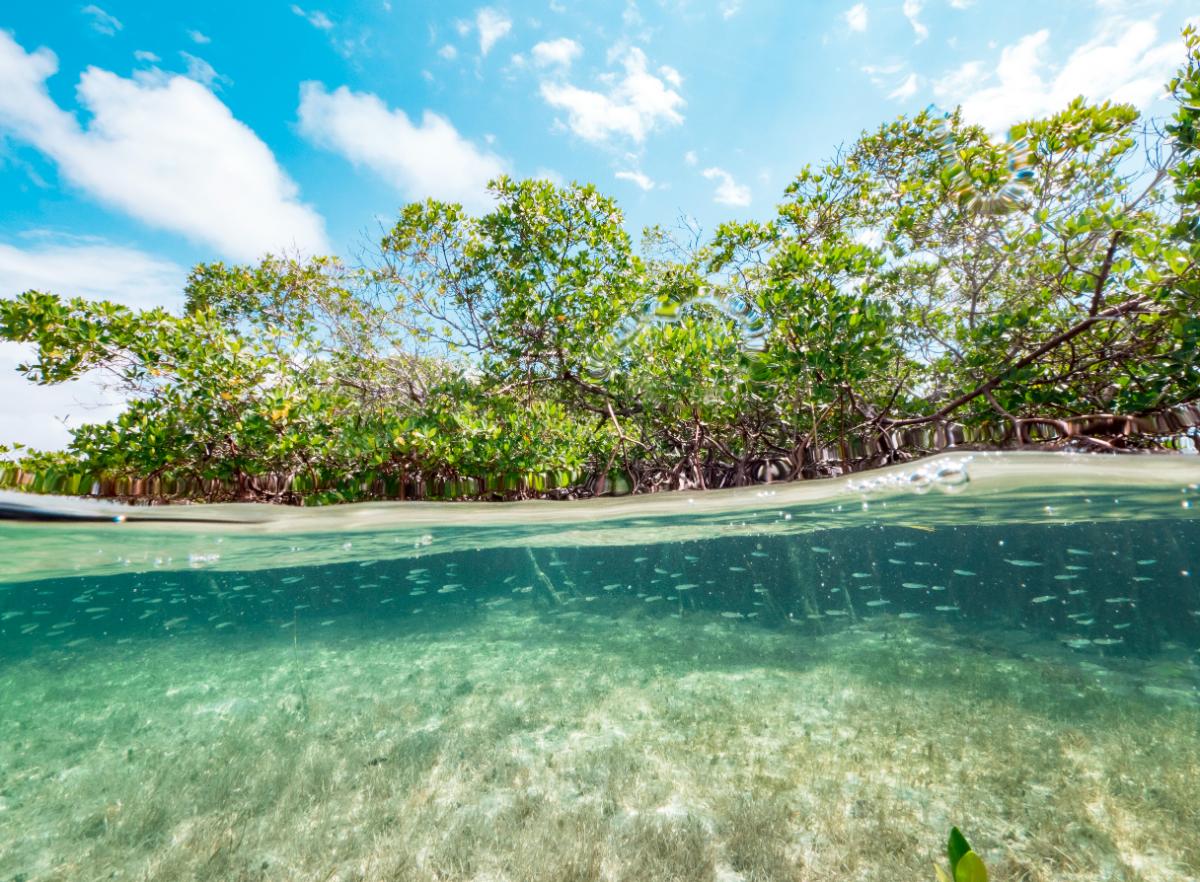
From left to right: Gray Kingbird eggs, Juvenile Green Heron and Red Mangroves in Bonefish Pond National Park
The first time I photographed a person planting a mangrove in the park was in 2017, during a volunteer event with Rotary International. Since then, I’ve probably snapped over 10,000 photos and recorded over 1,000 videos of others planting mangroves, picking up trash, or participating in a conservation impact activity in the park. Way before I took my first photo in the park, the BNT has been rallying and bringing people together to help restore Bonefish Pond.
The first cleanup effort happened in October of 2008. The BNT mobilized a group of volunteers consisting of youth, government officials, corporate partners, civil societies, BNT members and the public to tackle some of the more prominent piles of debris in one area of the park. This was along a dirt road that was cleared in the past to launch small boats at the water’s edge (the outermost part of the park is actually called Boat Harbour). Along with the assistance of heavy machinery including a backhoe and two heavy-duty crane trucks, over thirty-five (35) tons of debris was removed from the park that day. This area was later converted into the park’s main entrance road and parking lot.
“Along with the assistance of heavy machinery, over thirty-five (35) tons of debris was removed from the park that day.”

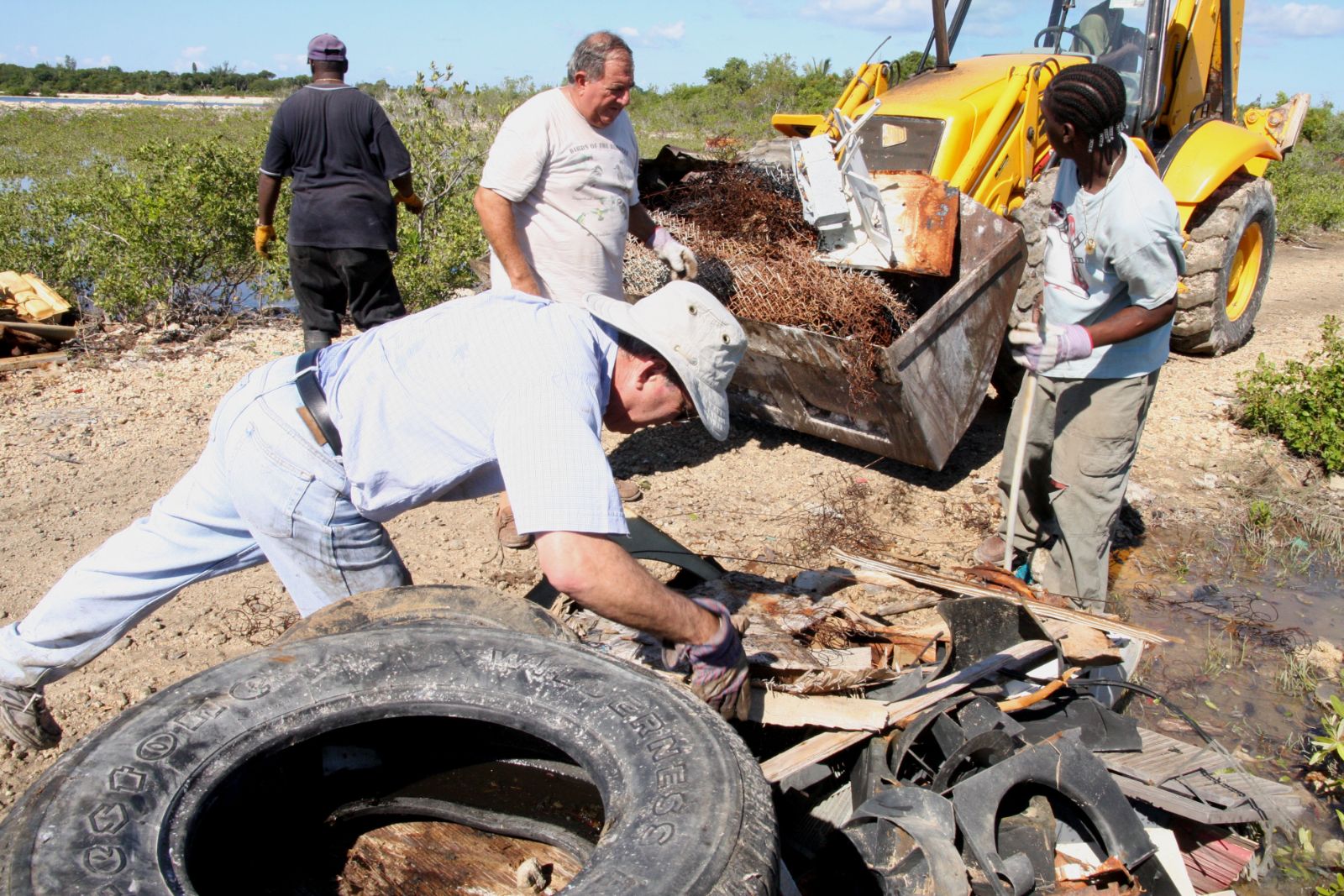

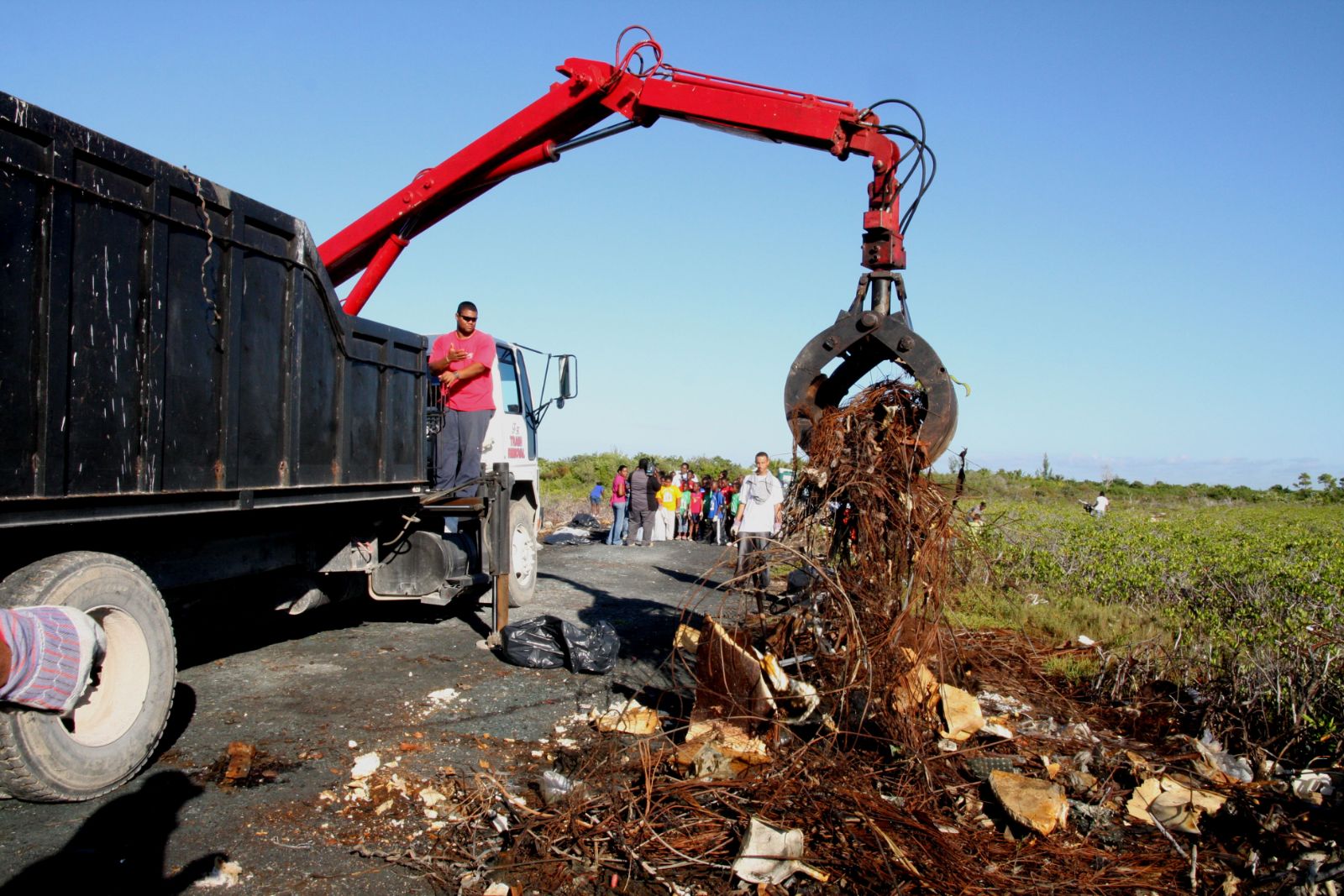
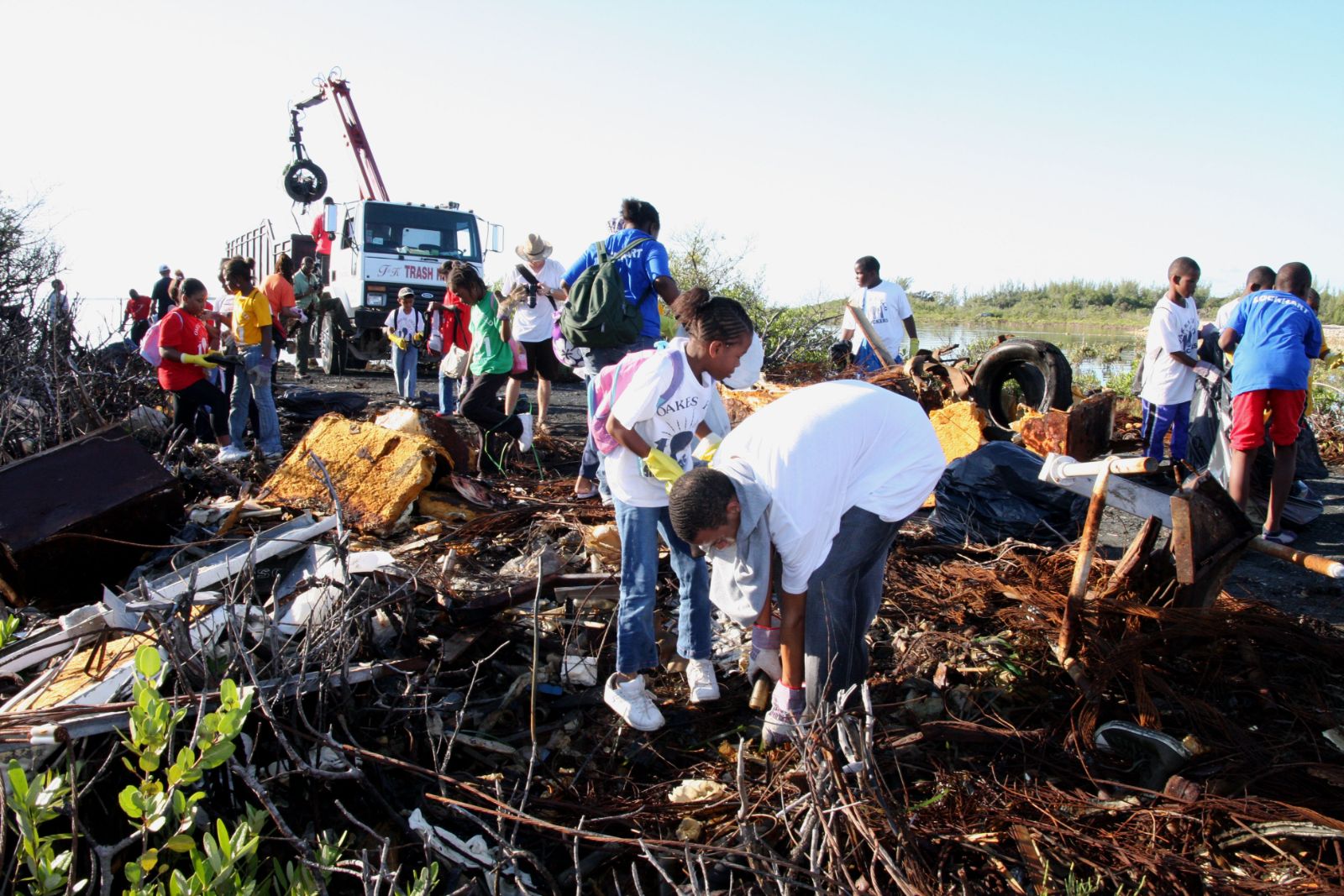
Photos from the very first major cleanup effort at Bonefish Pond. Photos by Bahamas Information Services
Since this major cleanup effort, the BNT has welcomed many groups to clean up the park and restore this national treasure. Debris removal still happens all over the park and has expanded to many other areas in the park, especially along the boundary of the park, which unfortunately has continued to be used as dumping sites. There have been numerous mangrove plantings as well. Currently one of the main planting areas is a small stretch of exposed limestone near the entrance of the boardwalk, that was cleared along with the main dirt road in the past. For the sake of this story, we’ll call this the “Main Mangrove Planting Area.”
Below are some of my favourite park restoration efforts recently, and also a look at some of the major restoration efforts in the past. Of course, this list isn’t all of the impactful actions that have happened at the park and only focuses on restoration and cleanup efforts:
2009 International Coastal Cleanup Day
Hundreds of volunteers came together for a cleanup at Bonefish Pond in honour of International Coastal Cleanup Day. Over four tons of debris were removed from the park on this day. There were a lot of people representing so many organisations, too many to list, but we had significant participation from The Governor General’s Youth Award (GGYA). This cleanup built upon the efforts of the 2008 cleanup and removed enough debris from the park to allow for the construction of park infrastructure. In the following year, we paved the main road, created the parking lot and constructed the amazing 600-foot boardwalk and gazebo with significant support from The Bahamian Government. You can read more about this cleanup effort here.

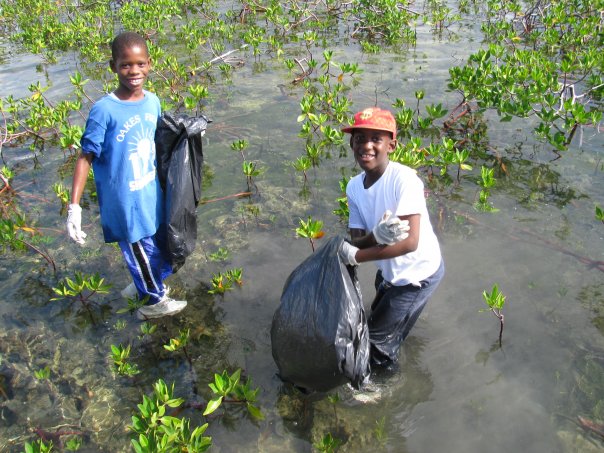
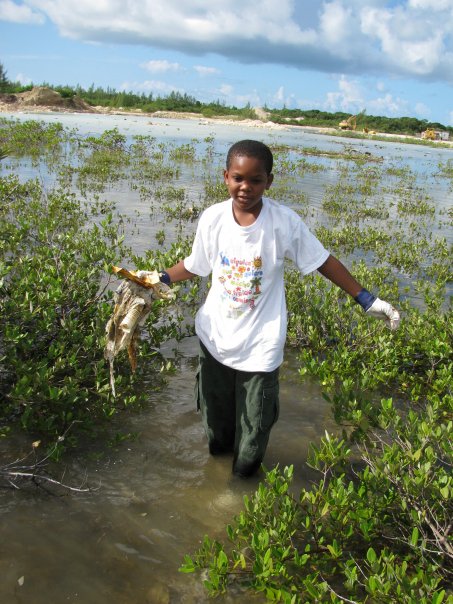
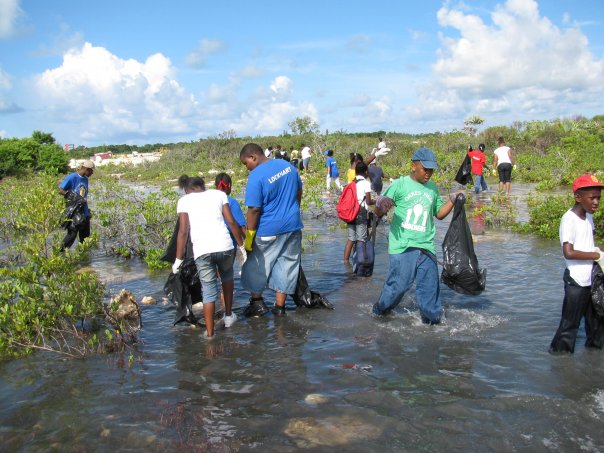
Photos from the 2009 International Coastal Cleanup Day. Photos by Blue Lagoon Bahamas
2013 Creek Restoration and Mangrove Planting
In 2013, The BNT along with a team of researchers and volunteers restored a mangrove creek to improve the flow of water and ecological productivity of the area. Prior to the establishment of the park, someone dredged a canal in the middle of the mangrove creek, possibly to allow the offloading of a small boat. The dead-end canal restricted water flow and served no purpose as a habitat for marine life. The BNT brought in an excavator to regrade the channel and planted over 600 red mangroves to convert the stagnant channel into a mangrove-fringed tidal creek capable of supporting fish and invertebrates. This project was supported by The Nature Conservancy through the Global Environment Facility Full-size Project. Heavy equipment is normally harmful to wetlands, but in this case, the project was executed very carefully to minimize disturbance to the natural environment.

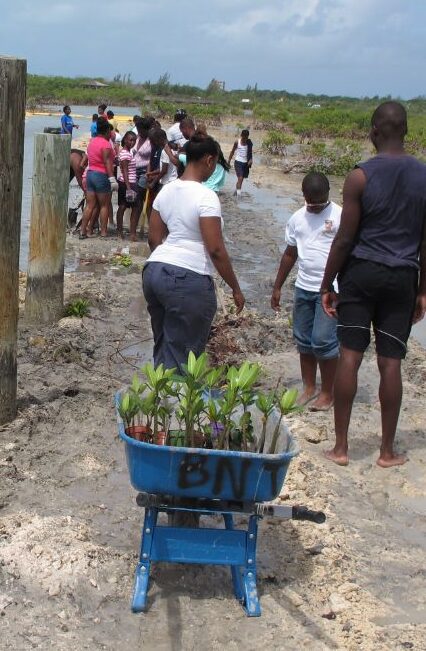


Photos from the 2013 Creek Restoration Project. Photos from Lindy Knowles.
2017 and 2018 Rotary Volunteer Efforts
In 2017, The BNT hosted a major volunteer activity with several local Rotary and Rotaract Clubs in New Providence. Fully prepared, everyone got down and dirty on this day. We planted several red and black mangroves at The Main Mangrove Planting Site and volunteers also dug a small channel through a ridge to allow better water flow to the area. In attendance were members of Rotary of East Nassau, Rotary Sunrise, Rotary South East, Rotary West and Rotaract. Also in attendance was Rotary International President Elect Barry Rassin. You can learn more about this effort by watching our video from the event here.

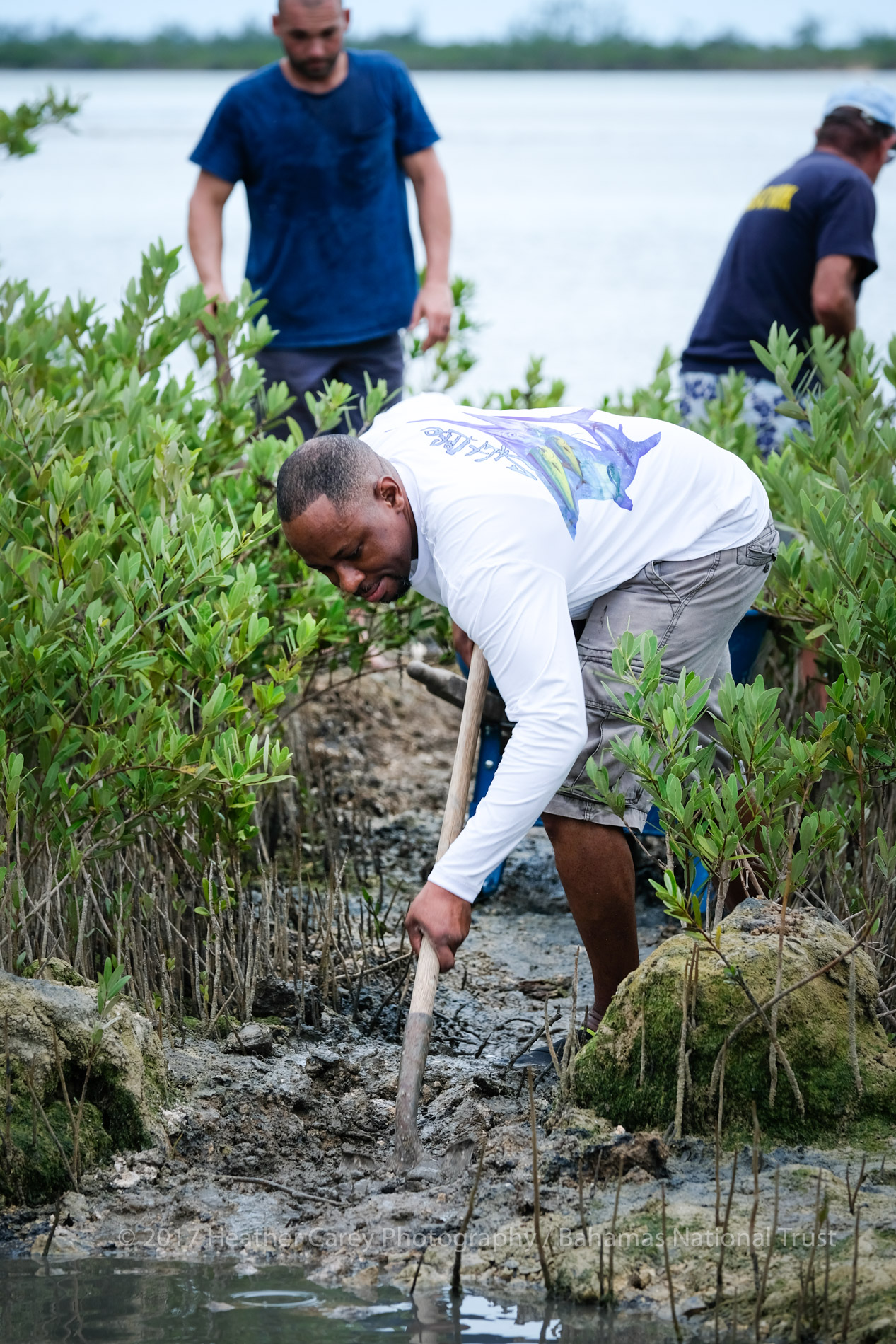
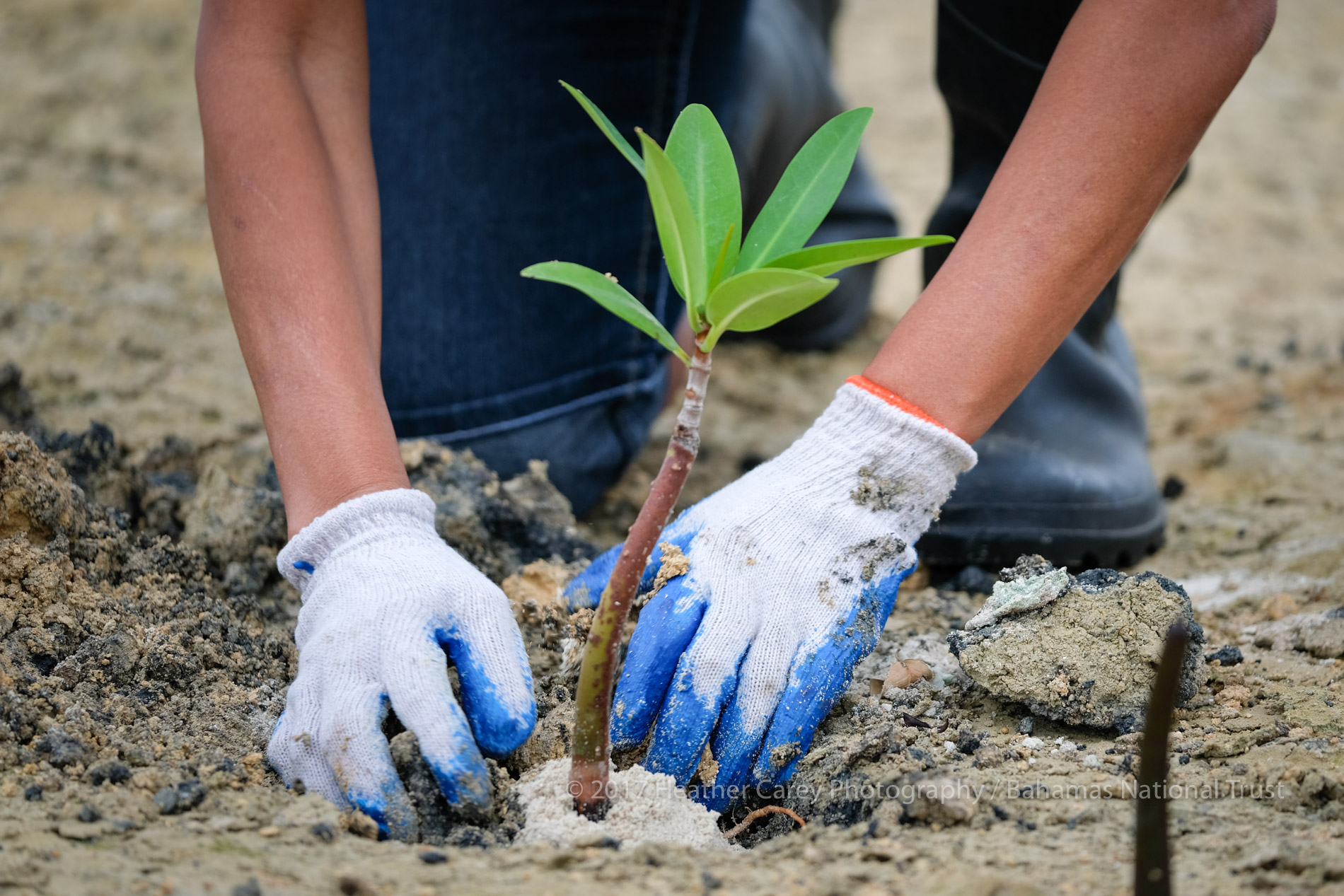
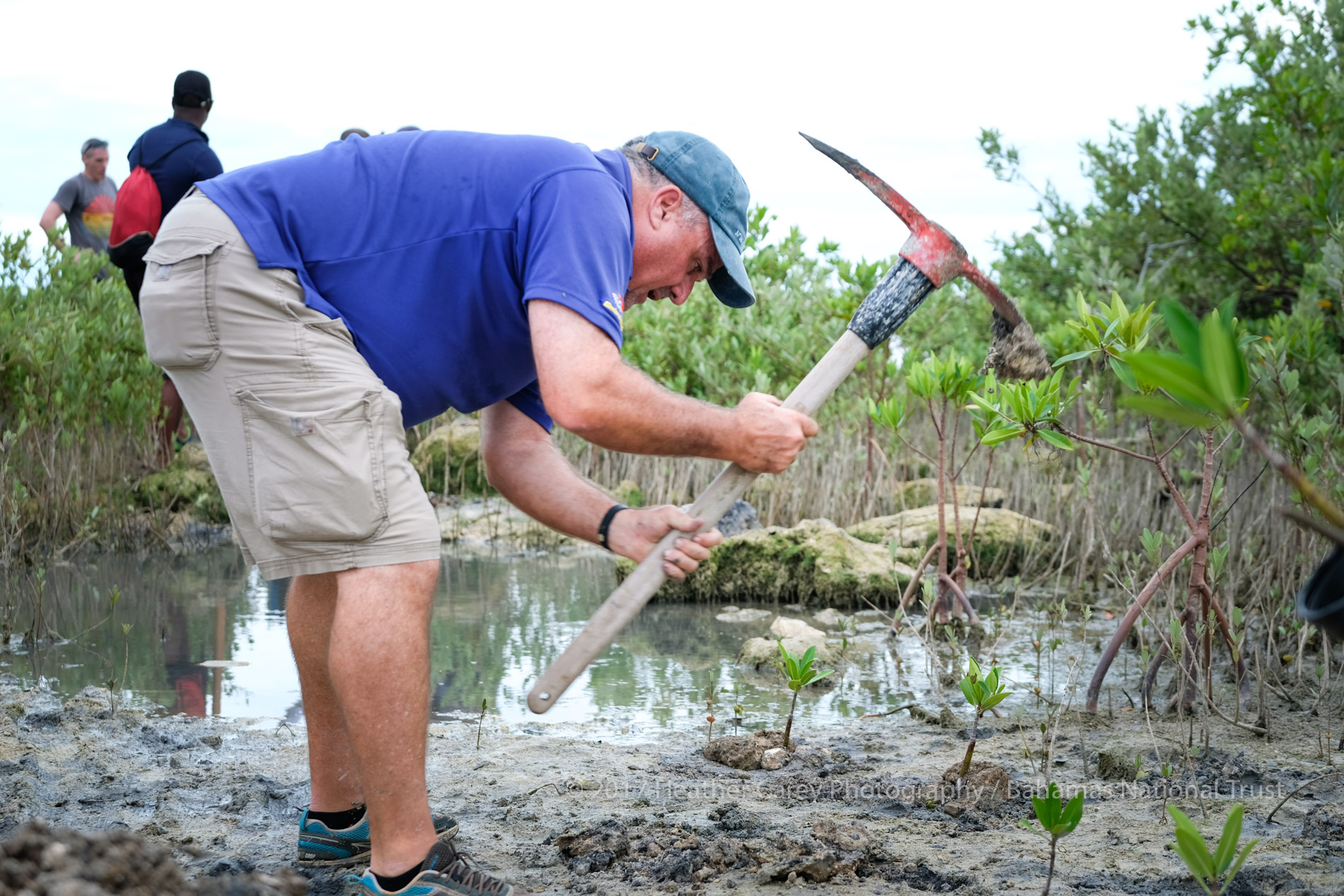
Photos showing Rotarians in action at the 2017 planting and restoration event. Photos by Heather Carey/Bahamas National Trust
In Spring 2018, The BNT welcomed members of Rotary International along with local Rotary clubs to the 2013 Creek Restoration Site to dig additional troughs for improved tidal flow and to help with debris removal. Simultaneously there were also groups at the Main Mangrove Planting Site planting red mangroves. We welcomed several members from Rotary Clubs in The USA who were more than excited to participate in local conservation.

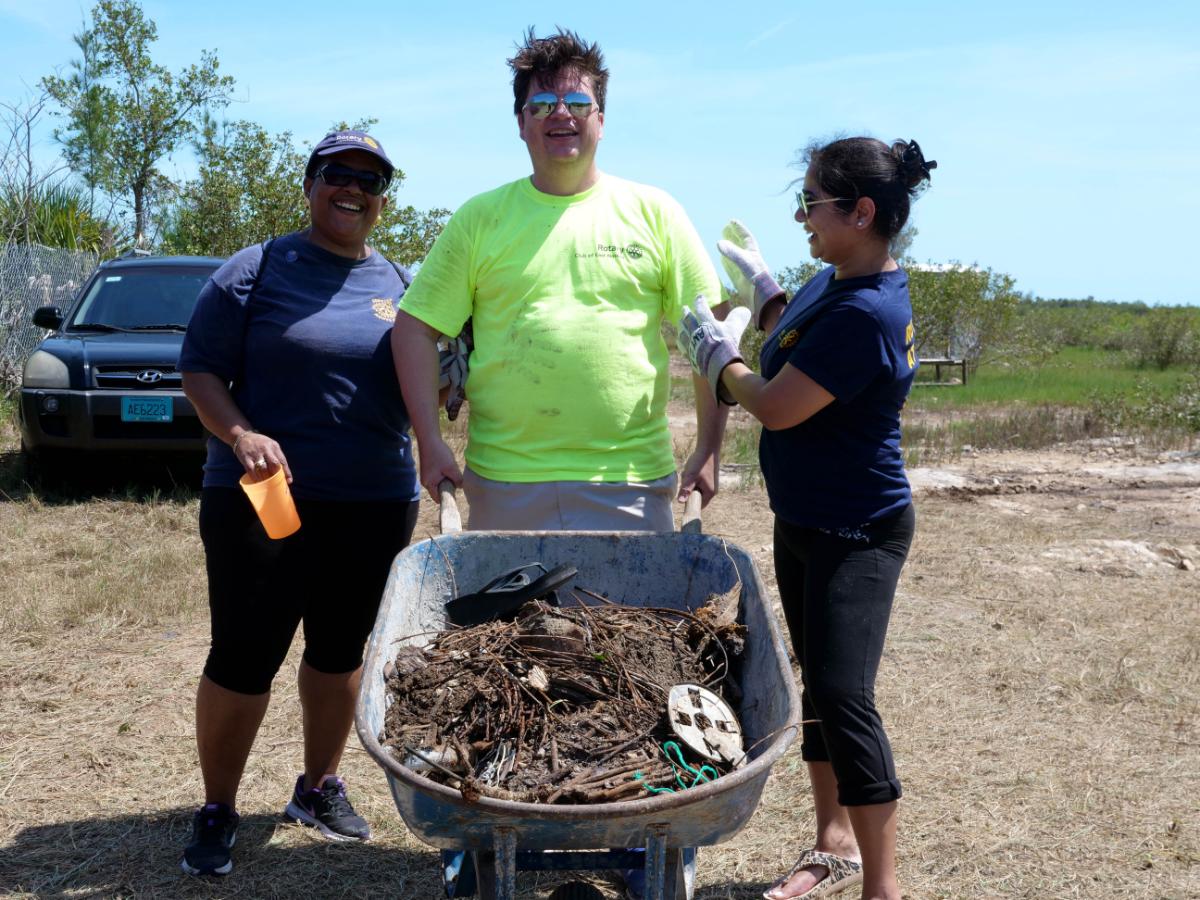
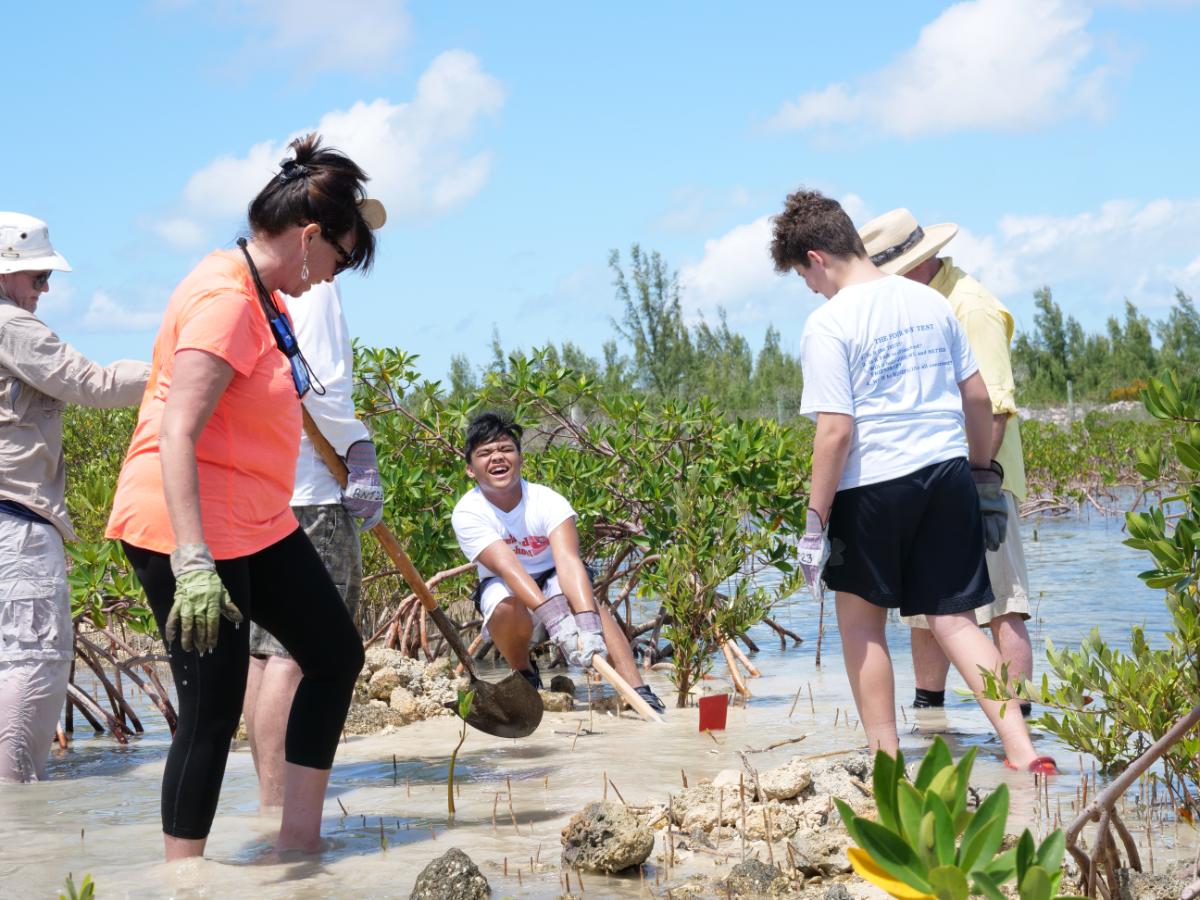
Photos showing Rotarians in action at the 2018 planting and restoration event.
2021 Corona World Oceans Day Cleanup and Planting
Perhaps my favourite restoration activity so far was in 2021 on World Oceans Day. We partnered with Corona Beer, and Jimmy’s Wine and Spirits to combat pollution, serve beer and protect paradise! This was the first time we did a cleanup that included a kayaking component. We had several volunteers go on kayaks and paddleboards and go out into the park in some of the harder-to-reach areas to tackle trash that had washed up in the park over the years. This meant we came back with kayaks loaded with nets, rope, plastic, styrofoam and even a fish pot. Along with the kayaking group, we also had groups cleaning up at the main recreation area, and along the northeastern boundary. At the end of it all, we planted several red mangroves in the planting area and served ice cold corona beers to top it all off. You can read more about this extra cool effort here.
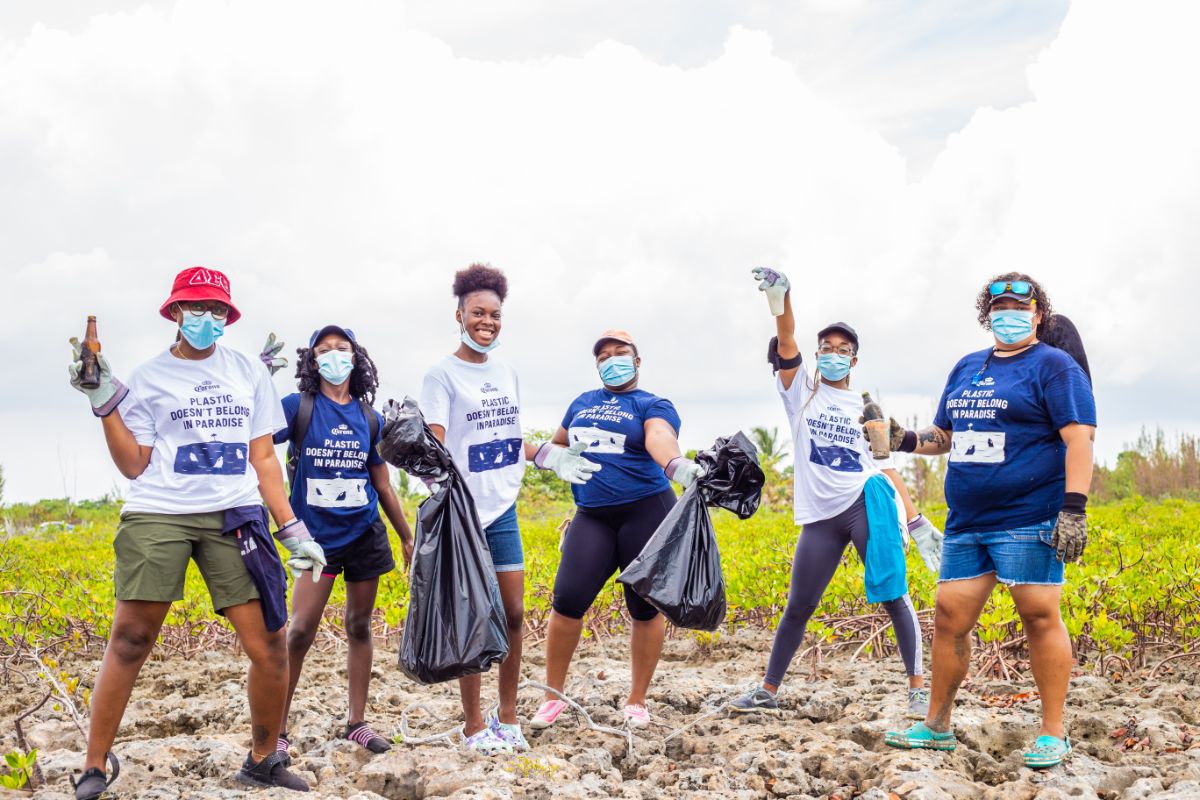
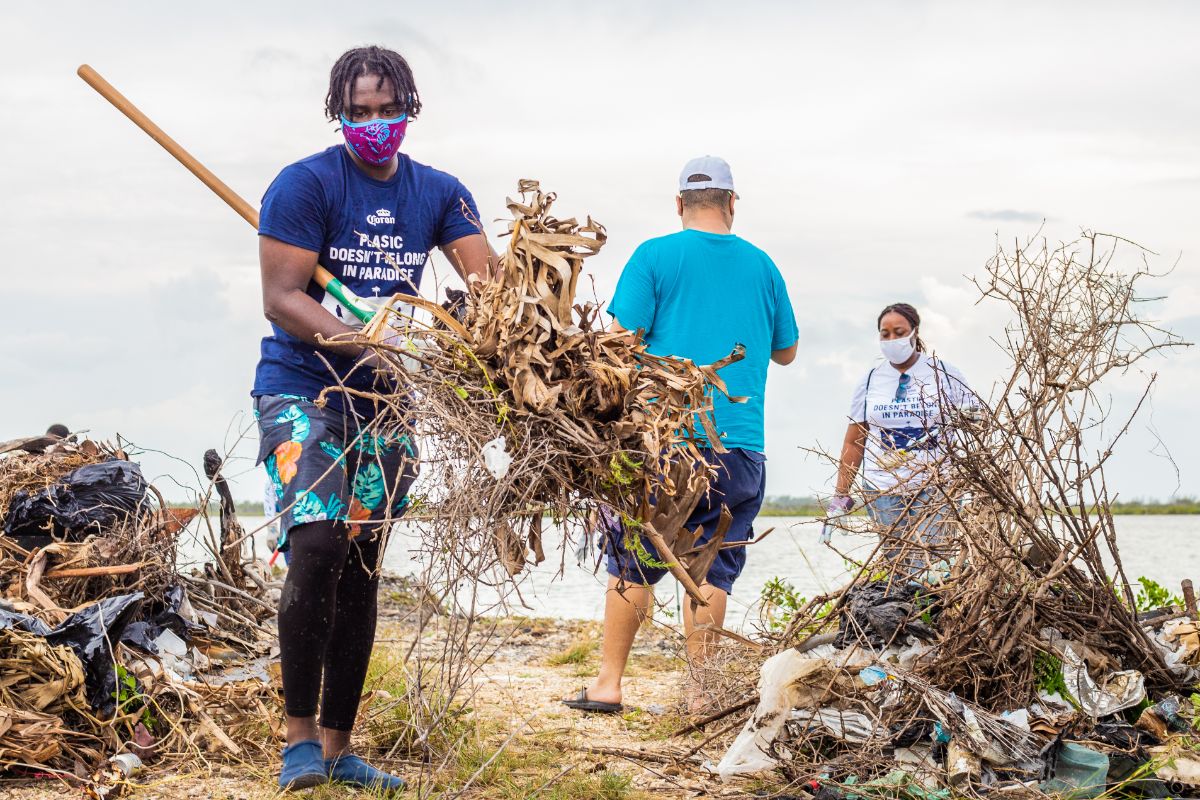
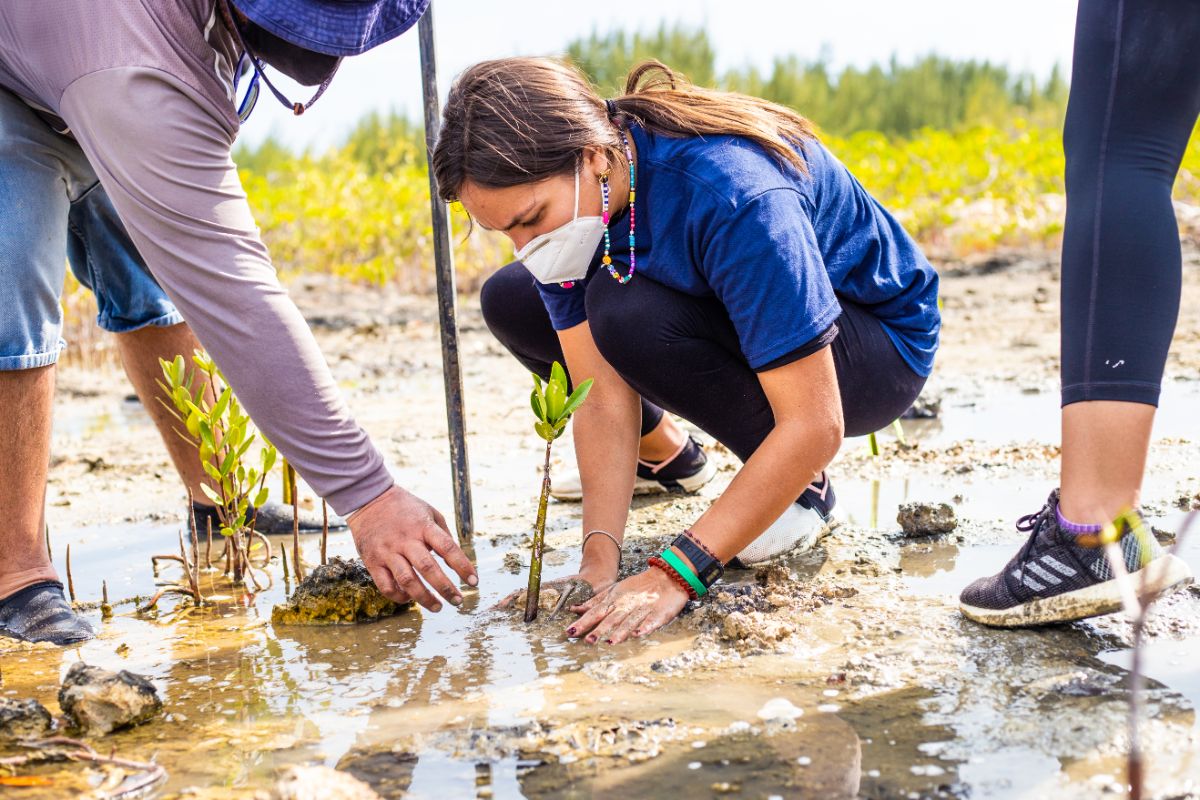

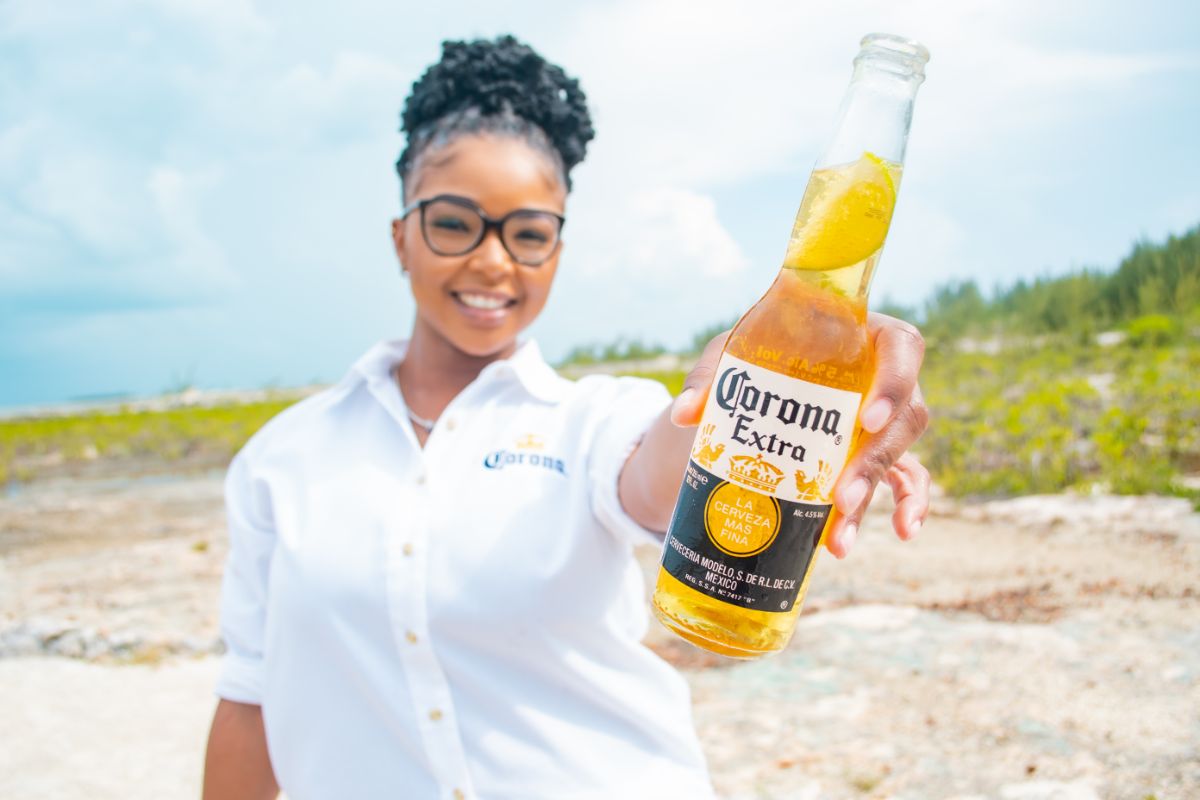
Photos from Left to Right: Volunteers from the University of The Bahamas in action, AB InBev Sales and Marketing Manager Elena Gonzalez plants a red mangrove, Volunteers cleanup trash that was dumped in the park, Superstar Kayaking cleanup group, Cold Corona Beers were served after the cleanup
2021 Diplomatic Corps Mangrove Planting
The BNT had the honour of hosting members of the Diplomatic Corps for a day of positive conservation impact at the park. The group of esteemed, engaged, and enthusiastic Diplomats had the chance to get down and dirty to plant some Red and Black Mangroves in the park. Those present included US Embassy Charge d’Affaires, Usha Pitts; British High Commissioner, Sarah Dickson; Caribbean Agricultural Research and Development Institute (CARDI) Country Representative, Dr Michele Singh; and Ambassador of Brazil, Claudio Lins. The planting was held right before COP26, a conference held by the United Nations that brings parties together to accelerate action towards the goals of the Paris Agreement and the UN Framework Convention on Climate Change.


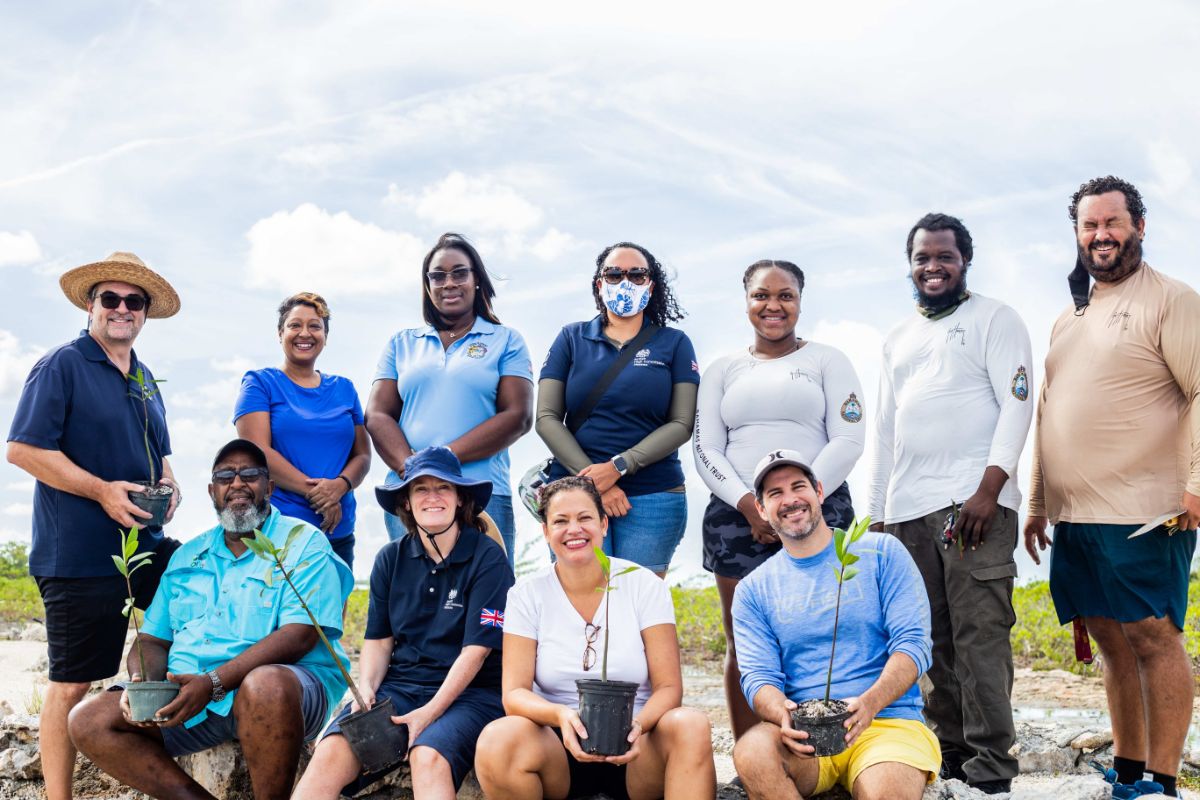
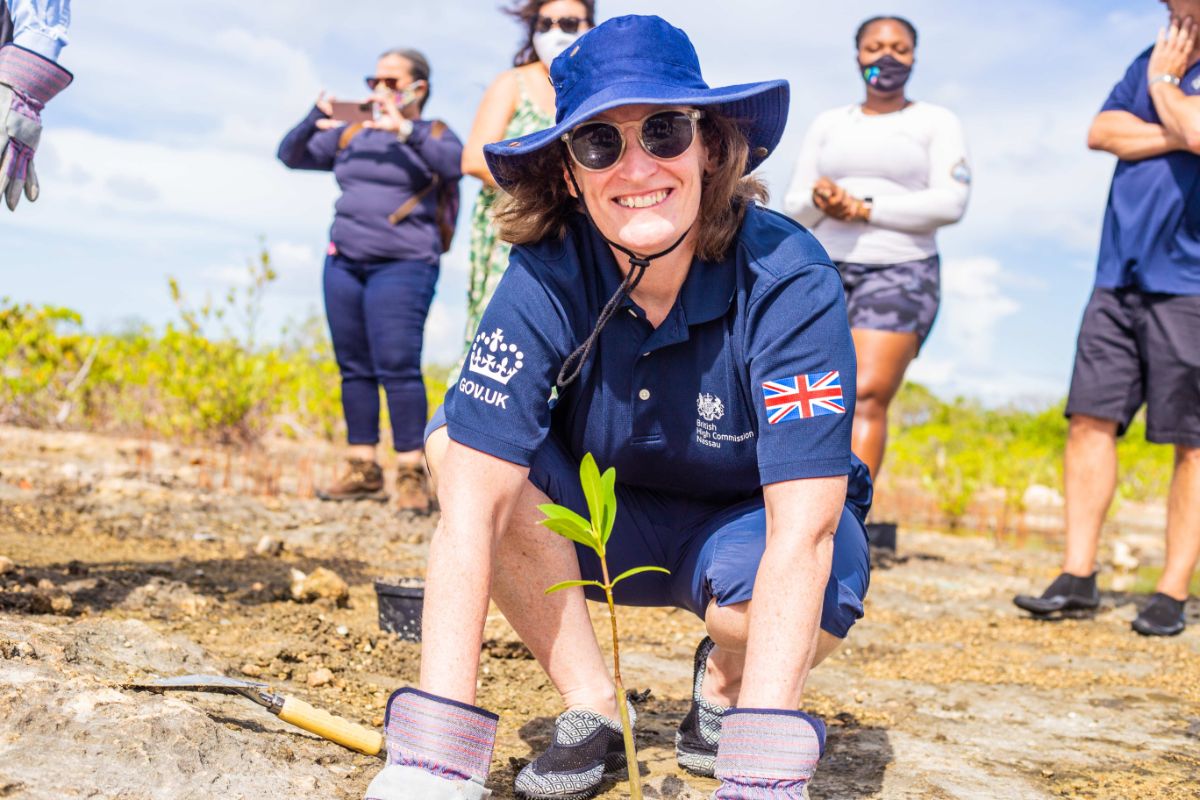
Photos from Left to Right: US Charge d’Affaires Usha Pitts digs a hole for a mangrove seedling, Ambassador of Brazil Claudio Lins plants a red mangrove, Diplomatic Corps Planting Crew with BNT Staff, British High Commissioner Sarah Dickson with a Red Mangrove seedling she just planted
2022 World Wetlands Day Planting
World Wetlands Day 2022 was the first time The United Nations officially recognized this special day as an official international day. World Wetlands Day is celebrated every year on February 2nd to raise awareness and support for wetland ecosystems. Under this year’s theme of “Wetland Action for People and Nature,” The Bahamas National Trust (BNT) hosted a celebratory mangrove planting at Bonefish Pond National Park. Participating in the mangrove planting were First Lady, Ann Marie Davis; Minister of Environment & Natural Resources, Vaughn Miller; Miss Bahamas Universe, Chantel O’Brian; Kimberly Darville, Assistant Director of Conservation at Baha Mar; representatives from the BNT, and more. We also hosted a small ceremony to recognize the day and highlight the importance of restoring areas like Bonefish Pond. Learn more here.


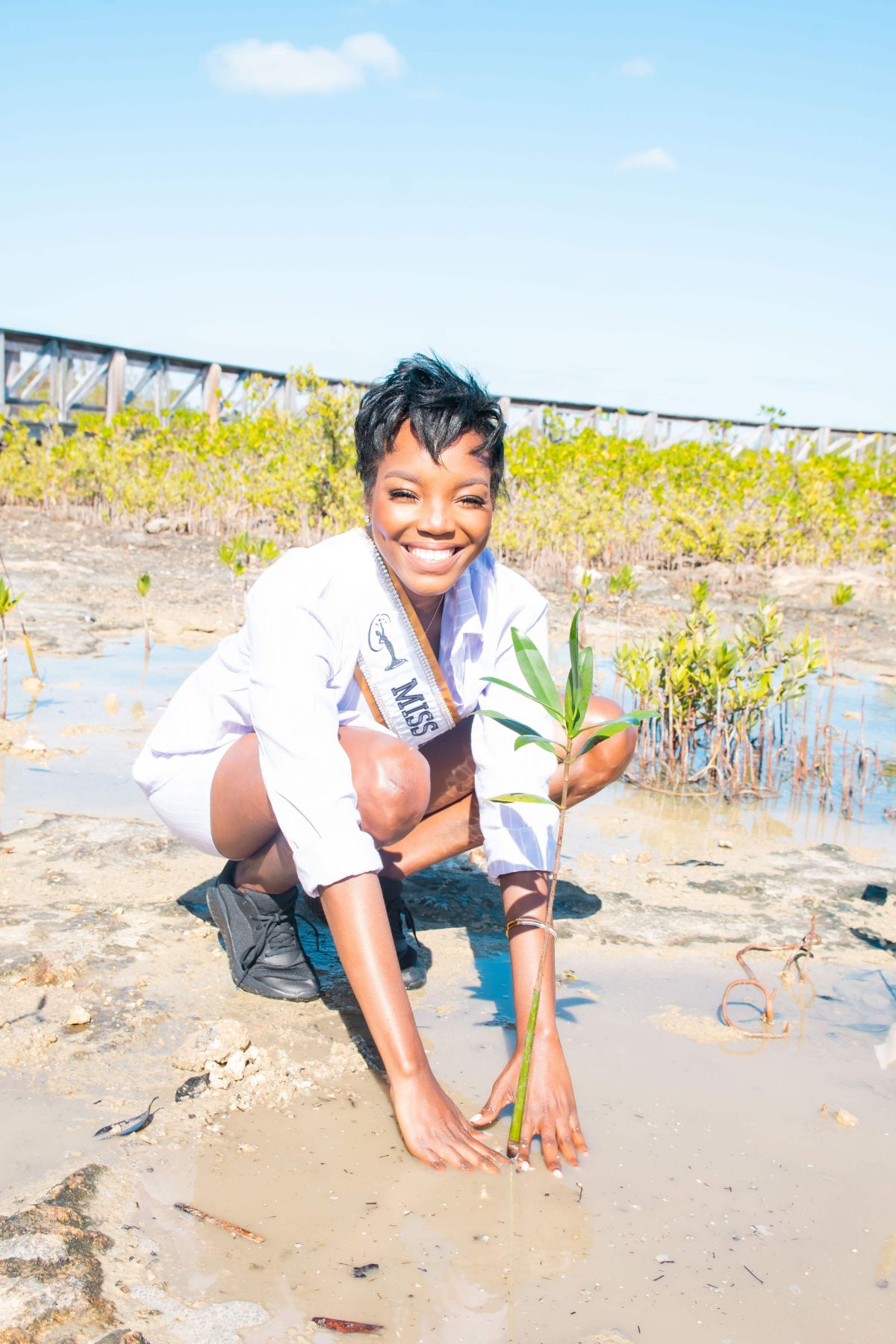
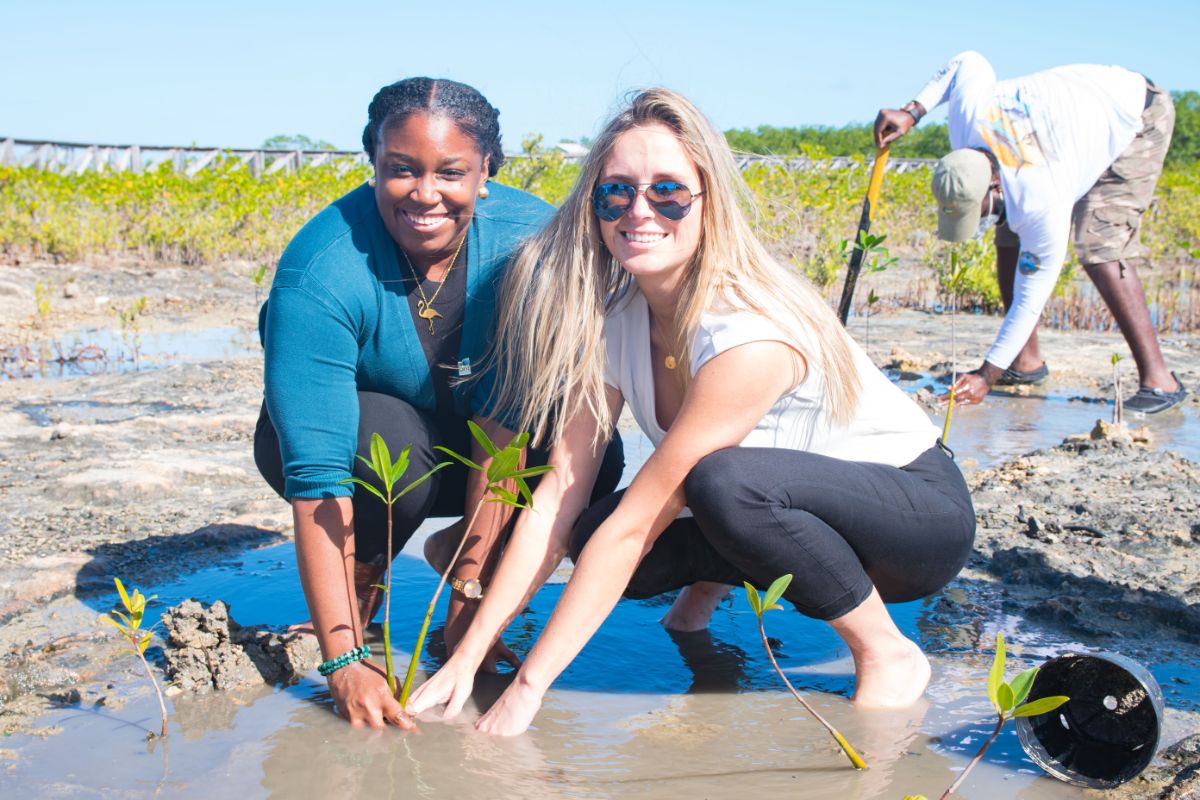
Photo from Left to Right: BNT President Geoff Andrews plants a mangrove with First Lady Ann-Marie Davis, Minister of The Environment and Natural Resources Hon. Vaughn Miller plants a Red Mangrove, Miss Bahamas Universe Chantel OBrian plants a red mangrove, BNT Partners from Bahamar Ranique and Kimberly plant red mangroves
2022 Bahamas All Pro Weekend Cleanup and Planting
We like to celebrate World Oceans Day with mangroves. For World Oceans Day 2022, we welcomed some NFL stars, BNT partners, and other volunteers to the park for a day of conservation impact which included planting mangroves and removing trash at the northeastern boundary. Even though a traditional beach clean-up was originally planned, all the players, trainers and others in attendance were happy to get down and dirty with the BNT team for some real impact. See the full story on this here.
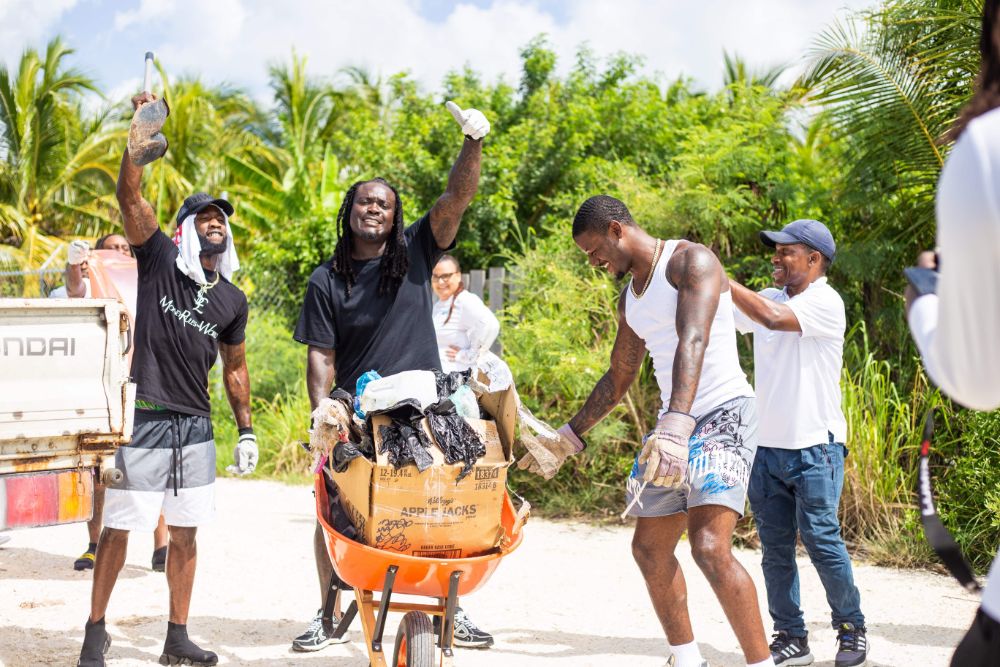

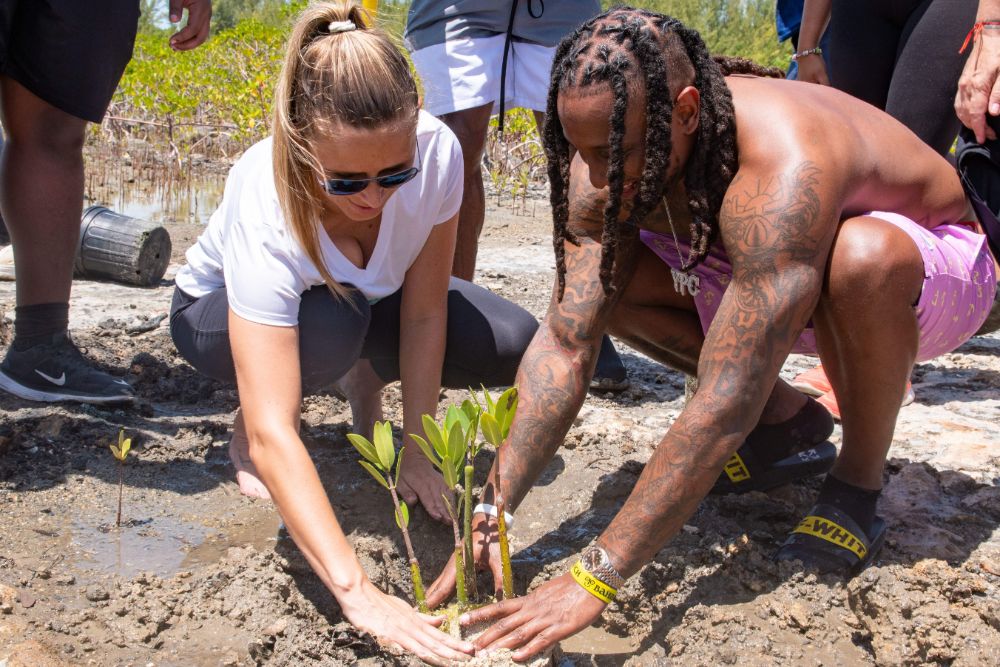
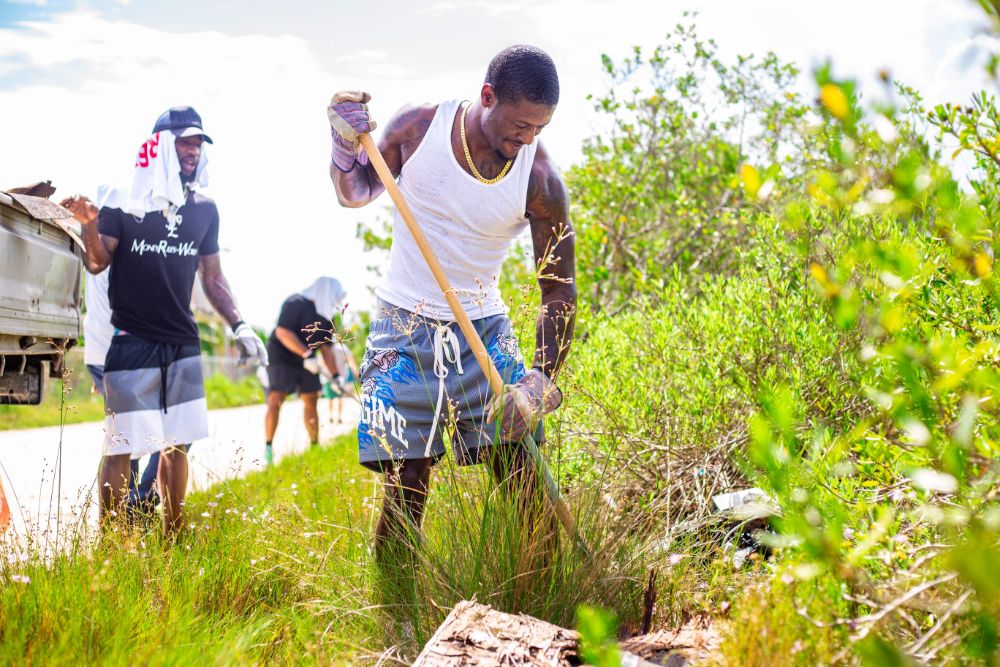
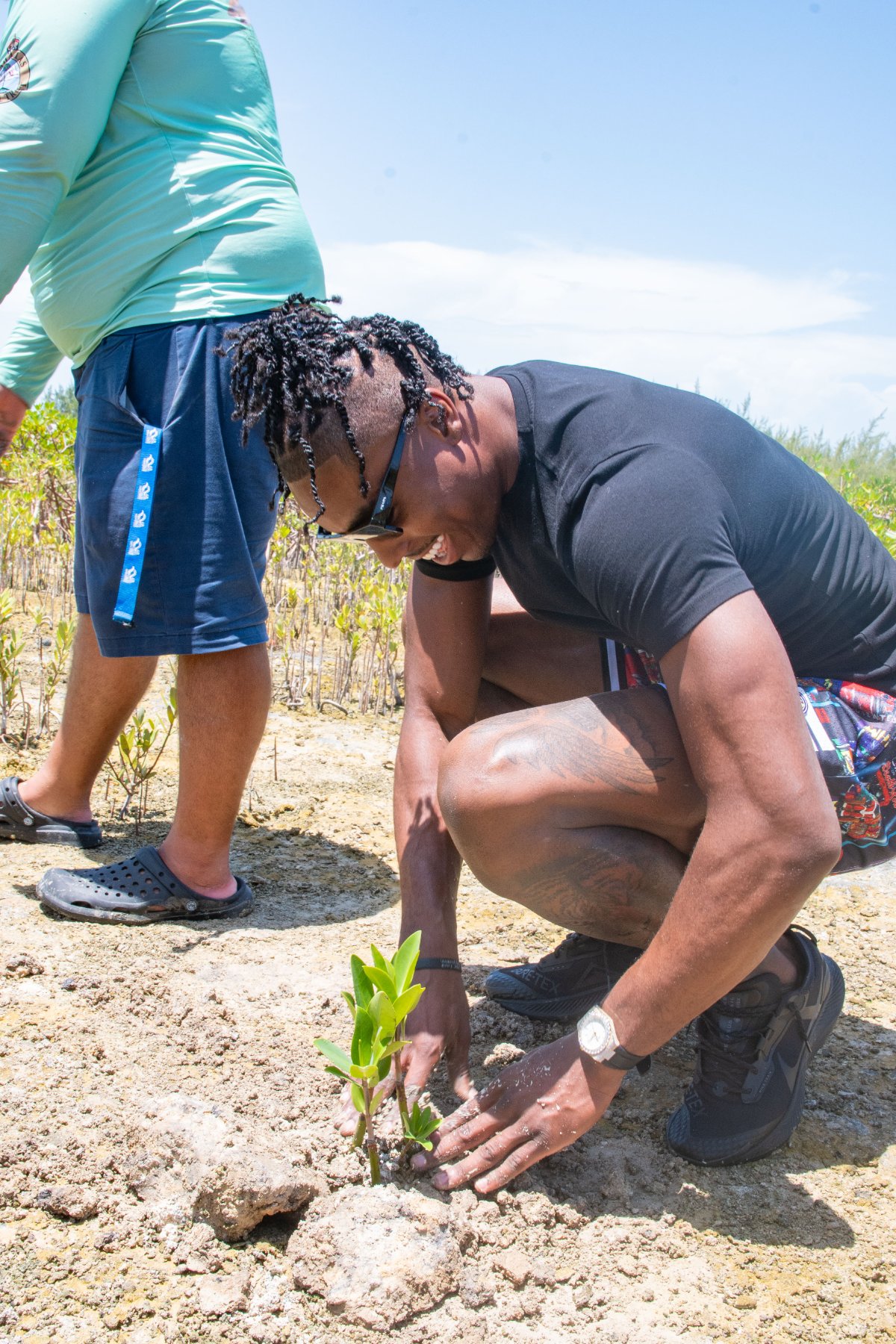
Photos from the Bahamas All Pro Weekend Planting and Cleanup
These are only some of the major and recent restoration events to happen at Bonefish Pond National Park. Throughout the last 10 years, there have been many other efforts that have played a significant role in restoring habitats in the park.
Mangrove planting has become one of the most popular and trending conservation activities, and even more now because of the mainstream conversations around topics like climate change and blue carbon. This means people are always reaching out wanting to plant mangroves. While these activities can be very impactful if done right, planting mangroves is just one of the ways we can restore these natural areas. Mangrove restoration can include removing debris, eradicating invasive species, improving the hydrology of an area and preventing additional degradation. Even when it comes down to the plants themselves, it can involve more than just planting red mangroves, there are other mangrove species and other plants that are key to ensuring healthy ecosystems.
The success of these conservation projects is thanks to the dedication and passion of past and present BNT Staff, a number of private and public partners, donors, members, and volunteers over the years. From international diplomats to Bahamian government officials, to athletes, to school students and everyday Bahamian citizens; Bonefish Pond National Park has been a space where people from around the world have had the opportunity to play a small role in preserving one of the greatest ecosystems on earth – mangroves.
Learning about and watching the conservation and leadership efforts for this park shown by people like Lindy Knowles, Agnessa Lundy, Dr Craig Dahlgren, Janeen Bullard, Anwar Rolle, Eric Carey and others in the past and present has shown me that their efforts are paying off. I am witnessing this park be restored to a healthy, flourishing ecosystem. I am grateful to have worked with many of these conservation champions and others who are not listed.
“Mangrove planting has become one of the most popular and trending conservation activities, because of the conversations around climate change.”

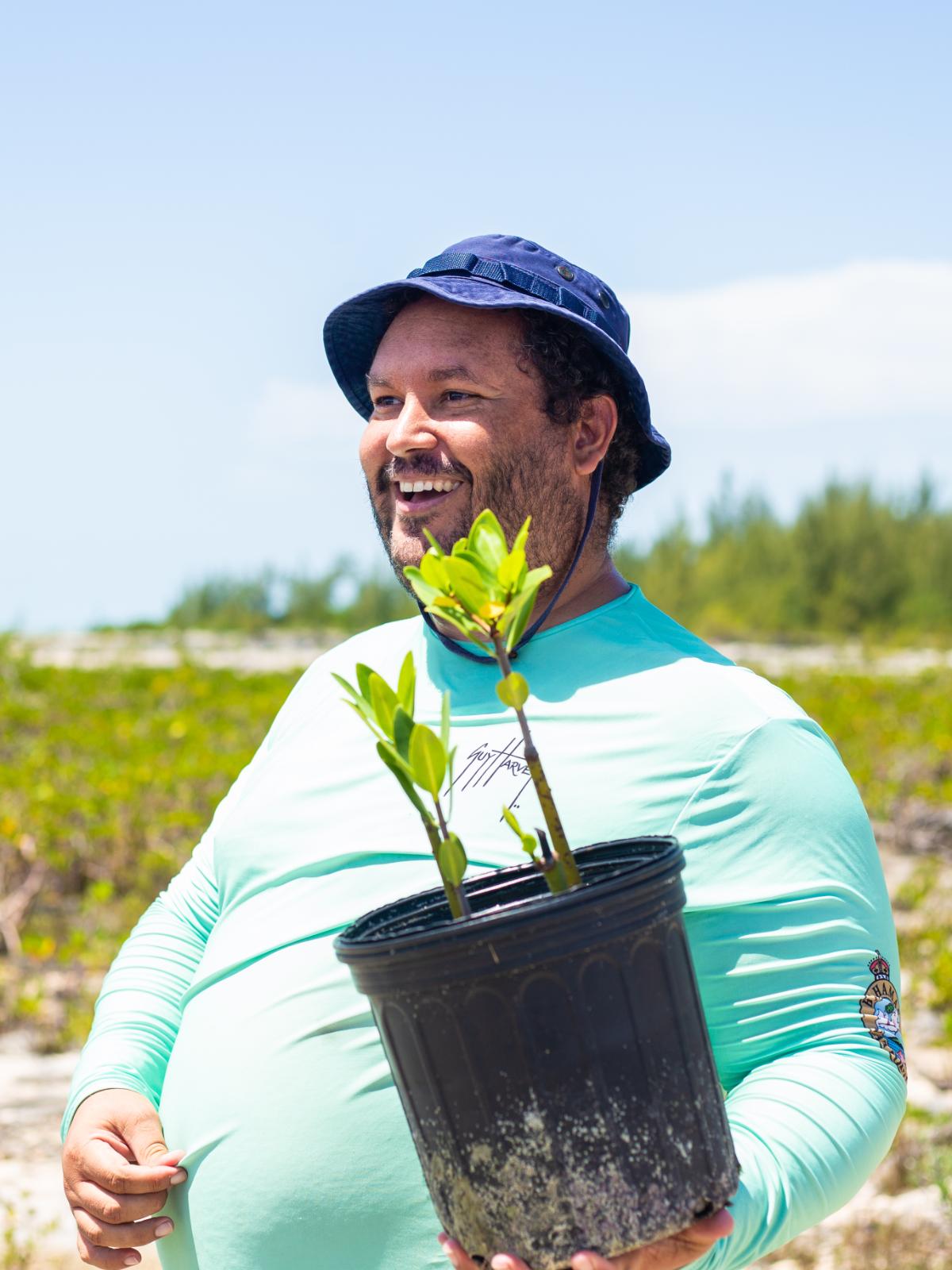


Some Bonefish Pond Conservation Champions (From left to right): Eric Carey during a cleanup, Lindy Knowles during a planting, Dr Craig Dahlgren with a juvenile spiny lobster during an assessment, Agnessa Lundy during a mangrove education activity
Special shoutout to many longtime corporate partners and organisations that have been crucial in supporting restoration efforts at Bonefish Pond from the very beginning. This includes The Government of The Bahamas, Atlantis Resort and Casino, GGYA, and Bahamas Waste. We are grateful to now welcome many new partners and continue working with our longtime corporate friends to preserve this important space.
The BNT will continue to restore and improve the habitats in The Bonefish Pond National Park. The next steps include developing a future restoration plan, a park management plan, and developing more park infrastructure to allow more people to experience the beauty of this incredible national park.
My hope is that one day a much bigger, more comprehensive study can be done to increase the understanding of the ecology of this area, longer-term monitoring efforts can be put in place, and we develop a restoration model that can be used in other degraded natural areas around the country
If you would like to support mangrove restoration at Bonefish Pond, and other mangrove conservation projects in The Bahamas, you can make a donation to our mangrove conservation program here.
If you would like to sign up to be a volunteer at The BNT and participate in an upcoming cleanup effort, you can fill out our volunteer form here. Make sure to state you want to be involved in mangrove cleanup and restoration activities.
“The BNT will continue to restore The Bonefish Pond National Park. Next steps include developing a park management plan, and developing more park infrastructure.”
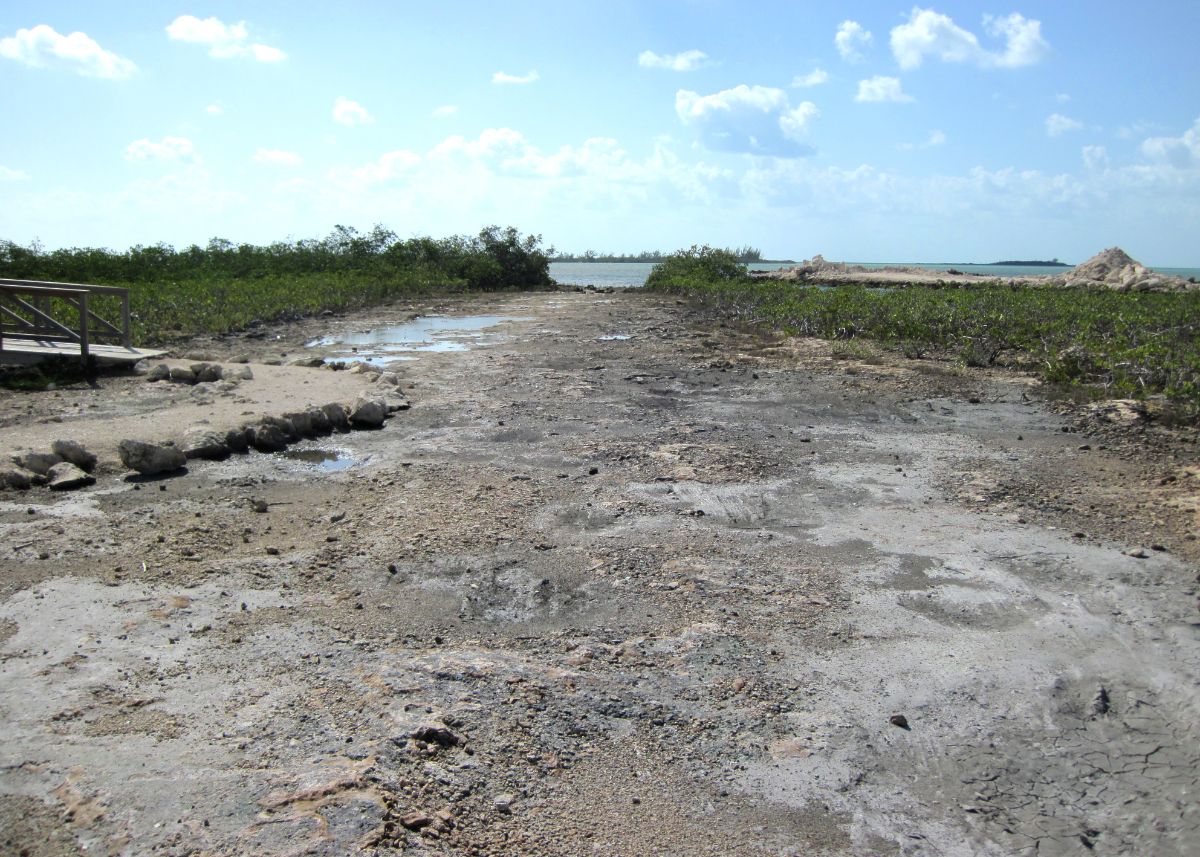
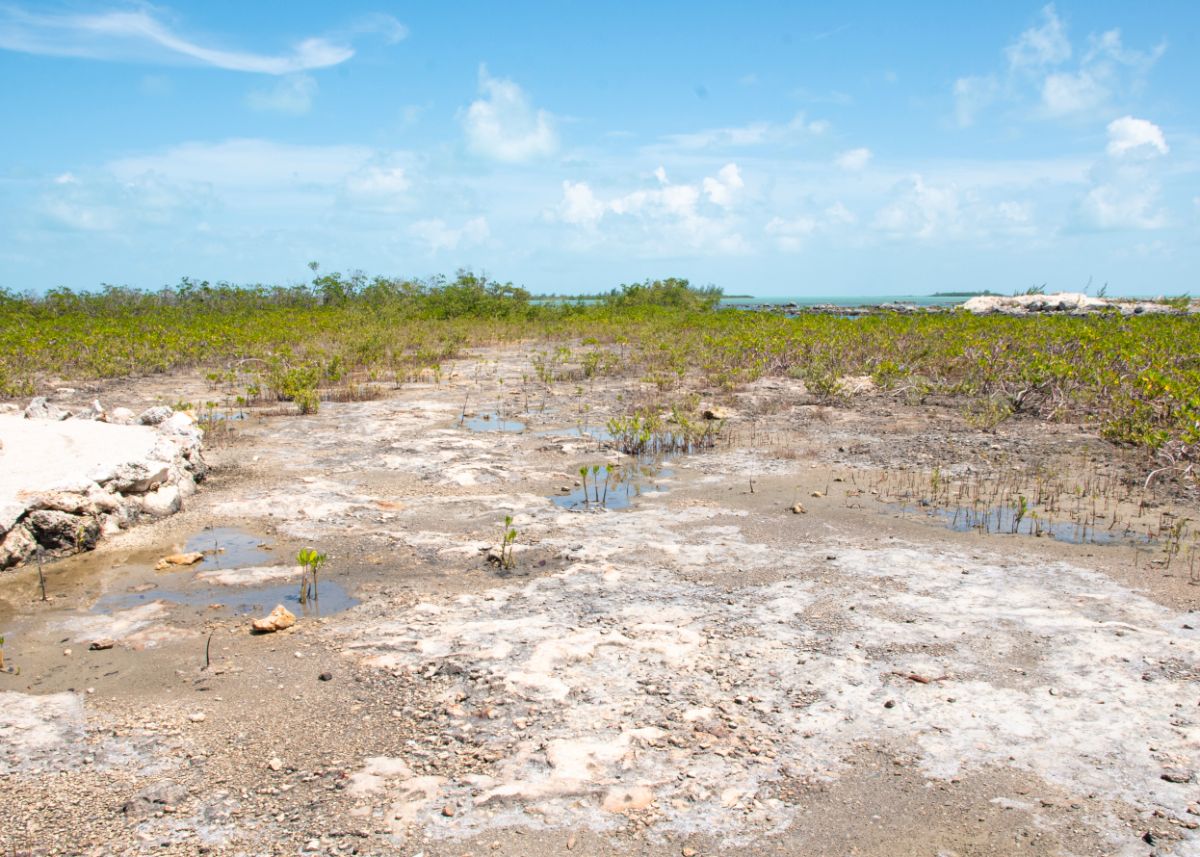
These two photos, taken exactly 10 years apart (2012 and 2022), show the restoration and recovery progress so far at the Main Mangrove Planting Area.
Elijah Sands is The Senior Communications Officer at The Bahamas National Trust.